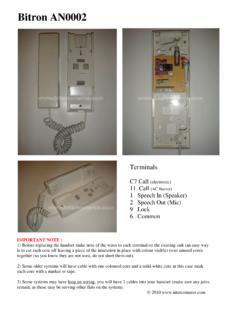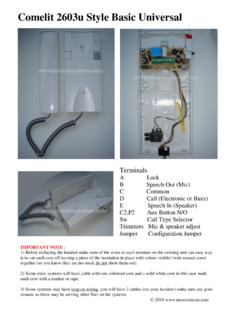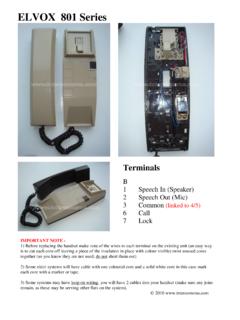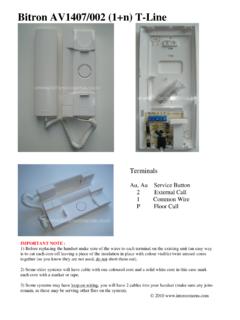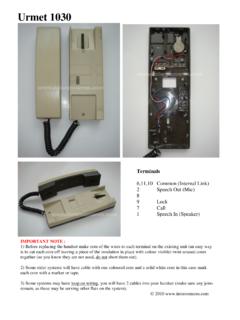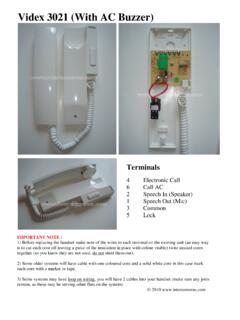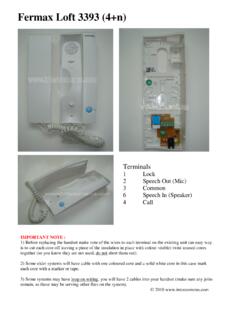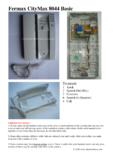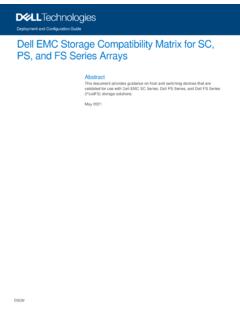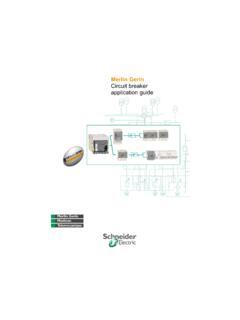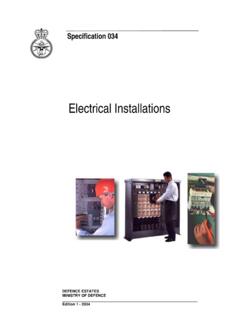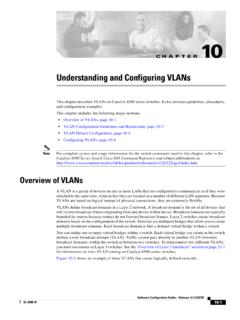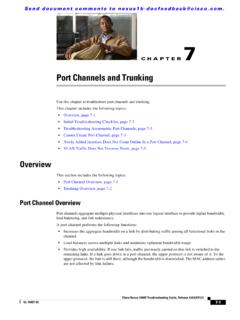Transcription of THE BASICS DOOR ENTRY AND ACCESS CONTROL SYSTEMS …
1 THE BASICS DOOR ENTRY AND ACCESS CONTROL SYSTEMS Intercoms R Us Ltd 2013 (c) system PLANNING Forward thinking and planning is essential and will save a lot of hassle in the long run and will ensure that your system looks neat and is well suited for the purpose. Often we go into brand new blocks of flats and have to run trunking everywhere because the architects have not given a single thought to the customer s requirements for ACCESS CONTROL and security. In multi-occupancy blocks doors need to be of commercial grade (NOT PVCu) with built in door closers and factory fitted with an Adams Rite Door Release or if a high risk area twin magnetic locks (built into the door jam) We are generally finding multi-point locking SYSTEMS which are totally useless for door ENTRY applications and lots of trouble when they go wrong.
2 The exit button, break-glass, fireman s switch etc can all be fitted and tubed back to a suitable junction point (ie to the panel or under-stairs cupboard) A TYPICAL system IS AS FOLLOWS : WHICH system SHOULD I CHOOSE ? Decisions, Decisions .. 1) Video ENTRY or Audio ENTRY ? 2) Do you need ACCESS CONTROL (ie keypad or proximity) 3) Style of panel (ie stainless steel, Brass, Aluminium, anti-vandal) 4) DDA Requirements 5) Style of handsets or monitors 6) Locking method (Fail Safe / Fail Secure) 7) Controls (ie exit button, break-glass, fire interface relay) system Wiring Currently there are many different types of system available : Audio SYSTEMS : 5 Wire Audio, 2 Wire Analogue Audio, 2 Wire Digital Audio, Wireless, GSM, IP, PABX, Direct Fixed Line Video SYSTEMS .
3 5 Wire & Coax, 4 Wire & Coax, 3 Wire& Coax, 4 Wire, 2 Wire, Wireless, IP Being old school I would always suggest a cabled solution Being old school I would always suggest a cabled solution as it is totally separate from other building services and therefore will operate if other networks or infrastructure fails, costs a little bit more at the point of installation, but has the advantage of NO ON-GOING CHARGES. Many new build council and social housing blocks are being built without cabling being run in and instead rely on fixed line or GSM solutions.
4 These are fine, but often you are reliant on the provider for altering the telephone numbers on the system when people move out (these services may not be free) so you may end up with a door ENTRY system that calls the bloke who used to live there ! . Particularly an issue if the block has a high turn over of tenants. You also have to consider the ongoing costs with these SYSTEMS ie cost of a fixed BT line or Mobile Phone Contract (or Pay As You Go) and call charges. (every time you get a visitor or time waster, it s adding to your bill) DDA REQUIREMENTS (AUDIO) If you are fitting a new system into a block of flats or offices, you are now required to provide accessibility for disabled users, there are a few different options these panels offer clear illuminated buttons, speak now and door open buttons and are often longer so that they are viable for able bodied users as well.
5 Whilst this is ok for 1 to 1 audio SYSTEMS things get a bit more complicated when you have multi-way SYSTEMS or video ENTRY BPT PANELS VIDEX PANELS BELL system (BSTL) PANELS If you have a receptionist, a large call switch (like the one shown below) can be linked to the call button for the reception handset, the button can be mounted at low level or on a post, so it is easily accessible to wheelchair users to call for assistance.
6 This then means the panel can be mounted at a more reasonable height for able bodied users TYPICAL DDA CALL SWITCH DDA REQUIREMENTS (VIDEO) With video ENTRY SYSTEMS there is an obvious problem with camera positioning, if the panel is mounted low (for disabled users) you may get a good picture of them, but a trouser shot of everyone else. The solution is to go for a system with a separate camera input, that way the buttons and speech unit can be set at an appropriate level and the camera fixed in a different location to provide a wider viewing angle of the door and caller.
7 Spot the problem with the system below THE BLACK CROSS ON THE WALL IS AT 5ft 7 (ie Average Height) LOOK AT THE HEIGHT OF THE CAMERA, TOTALLY USELESS !!!!!! IF YOU ARE GOING TO DO THIS, FIT AN AUDIO system AND SAVE YOURSELF A LOT OF MONEY AUDIO SYSTEMS (1 to 8 flats) For traditional 5 wire audio SYSTEMS an 8 core BT cable (conforming to CW1308) to each flat is usually sufficient (this leaves 3 spare cores for emergencies) if a second handset is required these can generally be looped on (to a maximum of 3 with AC call buzzers) with small SYSTEMS (typically 1 to 4 flats)
8 These can be run directly to the panel, also run a 12v supply cable from landlords cupboard and a lock release cable. LOCK CABLE : (position depends on lock type, for Yale Rim or Union Mortice types run to door jam, for Cisa types run across door to lock body (via a door loop) See lock section for magnets and other locking devices AUDIO SYSTEMS (LARGER SYSTEMS 9-20) For larger SYSTEMS , run all cables back to a junction box (ie under the stairs or where power can be drawn) then run sufficient cables to the front panel for call wires, power, speech and lock release (preferably a few spares too))
9 And join with connector strip neatly inside box (label all cables with flat numbers clearly. LOCK CABLE : (position depends on lock type, for Yale Rim or Union Mortice types run to door jam, for Cisa types run across door to lock body (via a door loop) See lock section for magnets and other locking devices AUDIO SYSTEMS (LARGE SYSTEMS 20-100+ FLATS) Once you get above 20 flats the panels can become too large and visually unacceptable (especially if space is limited), at this point you can either go with a elegant multi button panel (below)))
10 Or consider a 2 wire digital system , the wiring can remain the same as the previous SYSTEMS (unless cable spec from manufacturer is different) Lots of buttons, need not be ugly .. as these two demonstrate The 2 Wire Digital Audio Panel From Videx. IMPORTANT NOTE : If you choose to go with a digital audio door ENTRY system or video ENTRY it is worth picking a unit where the binary code is programmed in the handset via dip switches or jumper pins. If the handset does not have this set up, when the front panel goes wrong you will need ACCESS to all the flats in your block to re-program (ie learn) the handset to the panel.
